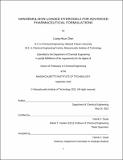Nanoemulsion-Loaded Hydrogels For Advanced Pharmaceutical Formulations
Author(s)
Chen, Liang-Hsun
DownloadThesis PDF (9.237Mb)
Advisor
Doyle, Patrick S.
Terms of use
Metadata
Show full item recordAbstract
Pharmaceutical formulation plays an important role in transforming a drug substance into the final drug product taken by a patient. It involves processes that combine an active pharmaceutical ingredient (API) and a mixture of inactive excipients into a final drug product with desired therapeutic effects and physical properties. Among various drug products, oral solid dosage forms are the most preferred product forms dominating the market because of their high patient compliance and wide acceptance. However, conventional oral drug formulations typically require costly multistep manufacturing, and poor bioavailability of hydrophobic APIs still remains a persistent challenge in many formulations. To address the limitations, we utilize two promising building blocks, nanoemulsions and hydrogels, to design new materials that enable more efficient and effective formulations of oral drug products with high quality and versatile release.
First, we present a method to encapsulate functional nanoemulsions in alginate capsules for more versatile delivery of lipophilic active ingredients. The nanoemulsions are intrinsically viscous, ensuring the formation of spherical capsules and large encapsulation efficiency. Quantitative release analyses show that the capsule systems possess a tunable, delayed-burst release. The proposed encapsulation methodology can be further generalized to other functional nanoemulsions with various active ingredients, oil phases, nanodroplet sizes, and chemically crosslinked inner hydrogel cores.
Second, we design a new thermogelling methylcellulose (MC) nanoemulsion that can be efficiently formulated into composite solid dosage drug products with well-controlled API nanocrystals embedded in a MC matrix. The composite drug products possess a fast and tunable release performance because of the fast-eroding MC matrix and successful formation of API nanocrystals. Using the versatile thermal processing approach, we formulate the nanoemulsion into various dosage forms (nanoparticle suspension, drug tablet, and oral thin film) in a manner that avoids nanomilling.
Finally, we develop thermogelling hydroxypropyl methylcellulose (HPMC) nanoemulsions as robust templates to formulate oral films loaded with poorly water-soluble drug nanoparticles. The thermally gelled network effectively immobilizes the oil nanodroplets for confined nanoparticle crystallization and avoids potential irreversible nanoparticle aggregation. The oral films possess a tunable immediate release, and a scaling rule is developed for designing the release profiles of oral films.
Date issued
2022-09Department
Massachusetts Institute of Technology. Department of Chemical EngineeringPublisher
Massachusetts Institute of Technology